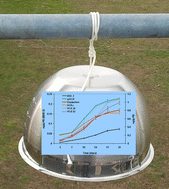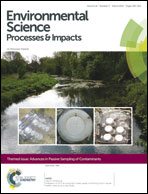Field calibration of low density polyethylene passive samplers for gaseous POPs†
Abstract
A field calibration study of low density polyethylene (LDPE) for measuring atmospheric concentrations of persistent organic pollutants (POPs) was performed in East Providence (RI), USA. LDPE samplers were collected after 3, 7, 10, 14, 17 and 21 days of exposure along with samples from a co-deployed high volume sampler. Uptake kinetics of POPs by LDPEs were confirmed both by using an uptake study over time and the inclusion of performance reference compounds (PRCs). Results indicated that only POPs with log sampler–air partitioning coefficient (KPE-A) ≤ 7.6 were approaching equilibrium by the end of the deployment period, whereas all the other POPs were still in the linear uptake rate. Sampling rates (1.0–80 m3 per day) were higher for some POPs when compared to literature values possibly due to the open sampler housing design used. Derived KPE-As for the detected POPs in field calibration study were correlated against the compounds' octanol–air partitioning coefficients (log KOA): [log KPE-A = 0.88 ± 0.02 × log KOA + 0.40 ± 0.21 (R2 = 0.96; n = 59; SE = 0.23)], and their subcooled liquid vapour pressures (log PL/Pa): [log KPE-A = −0.82 ± 0.02 × log PL + 6.22 ± 0.05 (R2 = 0.96; n = 59; SE = 0.22)] to predict values for all POPs. PL was generally found to be a better predictor of KPE-A for all POPs.

- This article is part of the themed collection: Advances in Passive Sampling of Contaminants

 Please wait while we load your content...
Please wait while we load your content...